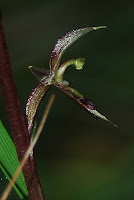 I managed to publish last night a report on the latest botanical oddities which I have found in the bush around Robertson. But there are others too, but their reporting got swamped in the politicking of the last few weeks.
I managed to publish last night a report on the latest botanical oddities which I have found in the bush around Robertson. But there are others too, but their reporting got swamped in the politicking of the last few weeks.Last week, I was out at the Kangaloon Aquifer with a local Aboriginal representative who mentioned that there were lots of tiny pale pink Orchids with two downward facing "petals". I knew the flower, of which he spoke, a thing known as Parsons Bands (because they have two lower "lateral sepals" which spread out prominently in front of the flower, reminiscent of an old clerical collar). I had only seen the occasional one or two.
So I went and checked them out, and in certain patches of the forested areas, there were hundreds of these little flowers, a mere 100mm high (approx 4 inches). As with many ground Orchids, they are fussy about position and soil types, but these guys less so than some species.
 While looking for those Parsons Bands, I also came across a far more unusual orchid, yet another of David Jones's as yet undescribed species. It is in the group known as "Tiny Greenhoods" (the "parviflora" group), which have now been re-classified away from the familiar Pterostylis genus, to a separate group called "Speculantha". The most obvious characteristic of this group of plants is their diminutive size, being a mere 125 mm high, (5 inches) (these ones). with the flowers less than 1 cm in size. Another characteristic is that they have inward facing flowers - two or more flowers on the stem, facing towards eachother. This is clearly illustrated here.
While looking for those Parsons Bands, I also came across a far more unusual orchid, yet another of David Jones's as yet undescribed species. It is in the group known as "Tiny Greenhoods" (the "parviflora" group), which have now been re-classified away from the familiar Pterostylis genus, to a separate group called "Speculantha". The most obvious characteristic of this group of plants is their diminutive size, being a mere 125 mm high, (5 inches) (these ones). with the flowers less than 1 cm in size. Another characteristic is that they have inward facing flowers - two or more flowers on the stem, facing towards eachother. This is clearly illustrated here.This flower is as yet un-named, but apparently it will be called "Speculantha furva", when officially described. The closest I could find, in the old books is Pterostylis nigricans, although there are subtle differences from that plant, in the size of the points of the lateral sepals, or "ears" - which are so often prominent on Greenhoods, but are barely protruding on the sides of these flowers. While the base of the flower is green and white, the upper part of the hood is dark chocolate brown when the flowers open. It appears that this changes to a rusty brown colour as the flower matures (at least I think that is the way the colour change progresses). The higher flowers appear to be newest, and they are the darkest.
 These tiny flowers appear straight out of the bare earth, in poor-grade yellowish sandy soil. They apparently grow rosettes of leaves, but not at flowering time (a situation which is not uncommon in the Greenhood tribe). I have published a poor quality photo (which I would not normally publish) just to demonstrate that feature, and the type of soil in which they were growing. Forgive the photography, but it is the best I have available, which shows that feature. There are 3 small "bract-like stem leaves" just visible on the flower stem (as usual, click to enlarge image).
These tiny flowers appear straight out of the bare earth, in poor-grade yellowish sandy soil. They apparently grow rosettes of leaves, but not at flowering time (a situation which is not uncommon in the Greenhood tribe). I have published a poor quality photo (which I would not normally publish) just to demonstrate that feature, and the type of soil in which they were growing. Forgive the photography, but it is the best I have available, which shows that feature. There are 3 small "bract-like stem leaves" just visible on the flower stem (as usual, click to enlarge image).The hardest ground orchids to illustrate are the Mosquito Orchids, which I also found. These were very fussy about location, for I found them only in one group of heavily shaded moist, black soil.

They have a single heart-shaped leaf, which hugs the ground. It is dark green, with a reddish purple underside. Small purple and grey flowers, on dark purple stems, growing in heavy shade. An amateur photographer's nightmare. These insubstantial flowers are about 1.5 cm in length, on about 6 inch stems (approx 150mm).
The Dark Mosquito Orchid is officially named Acianthus exsertus. The dorsal sepal is held well back from the protruding "column" (the main reproductive part of the flower), which is clearly visible in this photo.

No comments:
Post a Comment